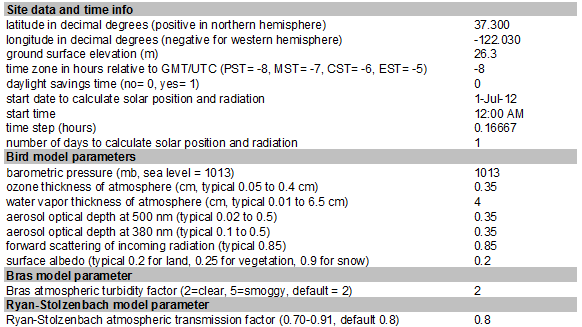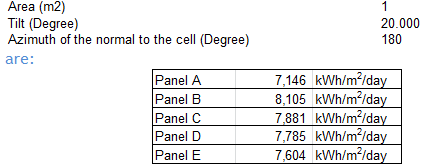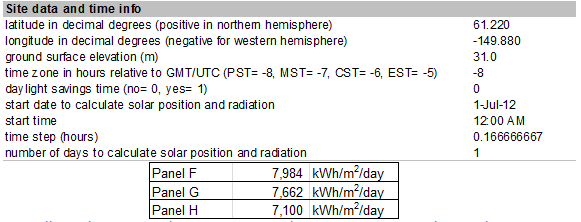a. Calculate the global radiation density (kWh/m2) received by five panels located in San Jose on July 1, 2012:

Panel A: Tilt=37.3o, Azimuth=180o (South)
Panel B: Tilt=0o, Azimuth=180o (South)
Panel C: Tilt=20o, Azimuth=180o (South)
Panel D: Tilt=20o, Azimuth=90o (East)
Panel E: Tilt=20o, Azimuth=0o (North)
Compare the results and comment. Ordered the panels in order of decreasing received global radiation density (kWh/m2)?
Results using Solrad and adjusting the tilt and Azimuth of the panel only:

We observe that the best radiation is obtained for a horizontal panel (B) because on June 21st, the sun is very high in the sky. Then come the 20o tilt and 37o tilt facing south (C and A). Orientation to East and North are less effective (D and E).
b. What is the sunrise, sunset times on July 1, 2012 in San Jose and when will the sun be South? Comment the results.
Reading directly the results of Solrad in the output tab, the sunrise corresponds to the time when the sun elevation passes from negative (under the horizon) to positive (above the horizon) in the morning. The sunset is the opposite in the evening.
Sunrise=4:50AM
Sunset=7:30PM
c. What will be the maximum altitude (height) of the sun in the sky of San Jose on July 1, 2012? Comment this result.
From Solrad output, the maximum altitude of the sun is 75.7o at 12:10PM. We know that the sun declination is about 23.45o at the summer solstice (June 21), which is close to July 1 (see Solar#16). When the sun is in the equator plane, its maximum height at a location is 90o-latitude, we have to add the declination in the summer so the maximum altitude of the sun at the summer solstice is:
90o-latitude+declination = 90-37.3+23.4 = 76.1o, close to 75.7o.
It happens at 12:10 PM because the location of San Jose is not exactly 120o West but 122o West (each degree is equivalent of 4' (360o in 24 hours)) so it adds 8' to the solar time. In addition, from Solar#18, the sun is behind of about 4' that we have to add to the time of maximum elevation which leads to 12:12PM. A calculation with a 1' time step confirms it.
d. What will be the global radiation density (kWh/m2) received by panels in Anchorage on July 1, 2012?
Panel F: Tilt=37.3o, Azimuth=180o (South)
Panel G: Tilt=0o, Azimuth=180o (South)
Panel H: Tilt=61o, Azimuth=180o (South)
Compare these results with values in San Jose and comment.
Anchorage latitude, longitude, altitude and time zone can be find in Wikipedia:61.22 North, 149.88 West, 31m and -8. These values are entered in Solrad and the simulation run.

Overall results are similar to San Jose's location. Even Panel F results are higher than Panel A with the same tilt because the day's duration is longer and a 37o tilt is also a better fit for Anchorage close to the summer solstice than for San Jose.
Excellent radiation can be obtained in summer in high latitude if the sky is clear. Cloudiness has more influence on solar resource than latitude.